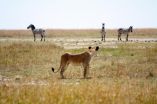Time management skills keep animals primed for survival
2014-12-18
(Press-News.org) Many animals may have a previously under-appreciated ability to make up for lost time with more effort, according to new research publishing this week in PLOS Computational Biology.
This capability could help scientists better understand how animals make efficient decisions in changing environments -- and ultimately help ensure the survival of a species.
Researchers from Princeton University challenge the conventional view that animals face a simple trade-off between the speed and the accuracy of their decisions. Adrian de Froment, Daniel Rubenstein and Simon Levin instead suggest that this picture of a two-way trade-off is missing a crucial third component: an ability to expend effort at a greater rate to compensate for any limit to the time spent making a decision.
The researchers use the theory of statistical decision-making to show that if an animal can control not only the time it invests in each decision, but also the amount of effort it invests within each unit of time, then it can swap effort for time as the situation demands. For example, if an animal comes under pressure to decide quickly, it can limit any loss in accuracy by expending more effort in the time that remains.
This flexibility gives an animal an advantage, in terms of Darwinian fitness, over individuals that are stuck with a simple trade-off between speed and accuracy, the researchers report. Because of this fitness advantage, the authors predict that the ability to control investment of time and effort separately should be widespread in nature.
Further work is needed to test this prediction, but if it is borne out, then this updated view of a three-way exchange between speed, effort per-unit-time, and accuracy could improve our understanding of efficient decision-making in all species, including humans.
INFORMATION:
Image Caption: Wild animals making decisions that need to be both fast and accurate.
Image Credit: Daniel Rubenstein
Image Link: http://www.plos.org/wp-content/uploads/2014/12/18-Dec-de-Froment-Lion.jpg
All works published in PLOS Computational Biology are Open Access, which means that all content is immediately and freely available. Use this URL in your coverage to provide readers access to the paper upon publication: http://www.ploscompbiol.org/article/info:doi/10.1371/journal.pcbi.1003937
Press-only preview: http://www.plos.org/wp-content/uploads/2014/12/plcb-10-12-de-Froment.pdf
Contact: Adrian de Froment
Address: Princeton University
Ecology and Evolutionary Biology
106a Guyot Hall
Princeton, NJ 8544
UNITED STATES
Phone: 001-609-258-6880
Email: adriandefroment@gmail.com
Citation: de Froment AJ, Rubenstein DI, Levin SA (2014) An Extra Dimension to Decision-Making in Animals: The Three-way Trade-off between Speed, Effort per-Unit-Time and Accuracy. PLoS Comput Biol 10(12): e1003937. doi:10.1371/journal.pcbi.1003937
Funding: We thank Princeton University, the Burroughs-Wellcome Fund and the National Science Foundation (Grant EF-1137894) for support. The funders had no role in study design, data collection and analysis, decision to publish, or preparation of the manuscript.
Competing Interests: The authors have declared that no competing interests exist.
About PLOS Computational Biology
PLOS Computational Biology features works of exceptional significance that further our understanding of living systems at all scales through the application of computational methods. All works published in PLOS Computational Biology are Open Access. All content is immediately available and subject only to the condition that the original authorship and source are properly attributed. Copyright is retained. For more information follow @PLOSCompBiol on Twitter or contact ploscompbiol@plos.org.
About PLOS
PLOS is a nonprofit publisher and advocacy organization founded to accelerate progress in science and medicine by leading a transformation in research communication. For more information, visit http://www.plos.org.
[Attachments] See images for this press release:

ELSE PRESS RELEASES FROM THIS DATE:
2014-12-18
Most vaccines work by inducing an immune response characterized by neutralizing antibodies against the respective pathogen. An effective HIV vaccine has remained elusive so far, but researchers have continued to make progress, often employing innovative methods. A study published on December 18th in PLOS Pathogens reports that a combination of antibodies from llamas can neutralize (destroy) a wide range of circulating HIV viruses.
After initial disappointment that HIV vaccine candidates were unable to elicit neutralizing antibodies, researchers found that some HIV-infected ...
2014-12-18
COLLEGE STATION -- A common over-the-counter drug that tackles pain and fever may also hold keys to a longer, healthier life, according to a Texas A&M AgriLife Research scientist.
Regular doses of ibuprofen extended the lifespan of multiple species, according to research published in the journal Public Library of Science-Genetics.
"We first used baker's yeast, which is an established aging model, and noticed that the yeast treated with ibuprofen lived longer," said Dr. Michael Polymenis, an AgriLife Research biochemist in College Station. "Then we tried the same process ...
2014-12-18
This news release is available in Japanese, French, Spanish and Chinese on EurekAlert! Chinese. The Rosetta spacecraft caught up with the comet known as 67P/Churyumov-Gerasimenko beyond Mars this August, and its preliminary results--along with the studies it will allow in the near-future--top this year's list of the most important scientific breakthroughs, according to the editors of Science.
This annual list of groundbreaking scientific achievements, selected by Science and its international nonprofit publisher, AAAS, also includes groundbreaking advances in medicine, ...
2014-12-18
Research led by the Teichmann group on the Wellcome Genome Campus has identified a fundamental mechanism for controlling protein function. Published in the journal Science, the discovery has wide-ranging implications for biotechnology and medicine.
The shape of a protein determines its function, for example whether it is able to interact with another protein or with a drug. But a protein's shape is not constant - it may change in response to different conditions, or simply as a matter of course.
Understanding how this process works is key to figuring out how to manipulate ...
2014-12-18
In the decade since the genome was sequenced in 2003, scientists and doctors have struggled to answer an all-consuming question: Which DNA mutations cause disease?
A new computational technique developed at the University of Toronto may now be able to tell us.
A Canadian research team led by professor Brendan Frey has developed the first method for 'ranking' genetic mutations based on how living cells 'read' DNA, revealing how likely any given alteration is to cause disease. They used their method to discover unexpected genetic determinants of autism, hereditary cancers ...
2014-12-18
The majority of RNA expression differences between individuals have no connection to the abundance of a corresponding protein, report scientists from the University of Chicago and Stanford University in Science on Dec. 18. The findings point to a yet-unidentified cellular mechanism that regulates gene expression and suggest studies that rely only on RNA measurements to characterize gene function require further analysis.
"The chief assumption for studies of RNA differences is that they ultimately reflect differences in an end product, which is protein," said senior study ...
2014-12-18
HANOVER, N.H. - Human cells are protected by a largely impenetrable molecular membrane, but researchers have built the first artificial transporter protein that carries individual atoms across membranes, opening the possibility of engineering a new class of smart molecules with applications in fields as wide ranging as nanotechnology and medicine.
The study, which appears Friday, Dec. 19, in the journal Science, is a milestone in designing and understanding membrane proteins. A PDF is available upon request. The study was conducted by researchers from Dartmouth College, ...
2014-12-18
A study of the way malaria parasites behave when they live in human red blood cells has revealed that they can rapidly change the proteins on the surface of their host cells during the course of a single infection in order to hide from the immune system.
The findings, which overturn previous thinking about the Plasmodium falciparum parasite's lifecycle, could explain why so many attempts to create an effective vaccine have failed and how the parasites are able to survive in the human body for such long periods of time.
In the study, Plasmodium falciparum parasites were ...
2014-12-18
Scientists and engineers have built a computer model that has uncovered disease-causing mutations in large regions of the genome that previously could not be explored. Their method seeks out mutations that cause changes in 'gene splicing,' and has revealed unexpected genetic determinants of autism, colon cancer and spinal muscular atrophy.
CIFAR Senior Fellow Brendan Frey (University of Toronto) is the lead author on a paper describing this work, which appears in the Dec. 18 edition of Science Express. The paper was co-authored by CIFAR senior fellows Timothy Hughes (University ...
2014-12-18
The evolution of trichromatic color vision in humans occurred by first switching from the ability to detect UV light to blue light (between 80-30 MYA) and then by adding green-sensitivity (between 45-30 MYA) to the preexisting red-sensitivity in the vertebrate ancestor. The detailed molecular and functional changes of the human color vision have been revealed by Shozo Yokoyama et al. Emory University and is published in the journal PLOS Genetics.
The molecular basis of functional differentiation is a fundamental question in biology. To fully appreciate how these changes ...
LAST 30 PRESS RELEASES:
[Press-News.org] Time management skills keep animals primed for survival



